Project Management: Negotiation, Governance, and Functions
VerifiedAdded on 2023/05/28
|16
|5363
|173
AI Summary
This article covers various aspects of project management such as negotiation strategies, project governance structure, project functions, and more. It also includes a sample WBS and project charter. Read on to learn more.
Contribute Materials
Your contribution can guide someone’s learning journey. Share your
documents today.
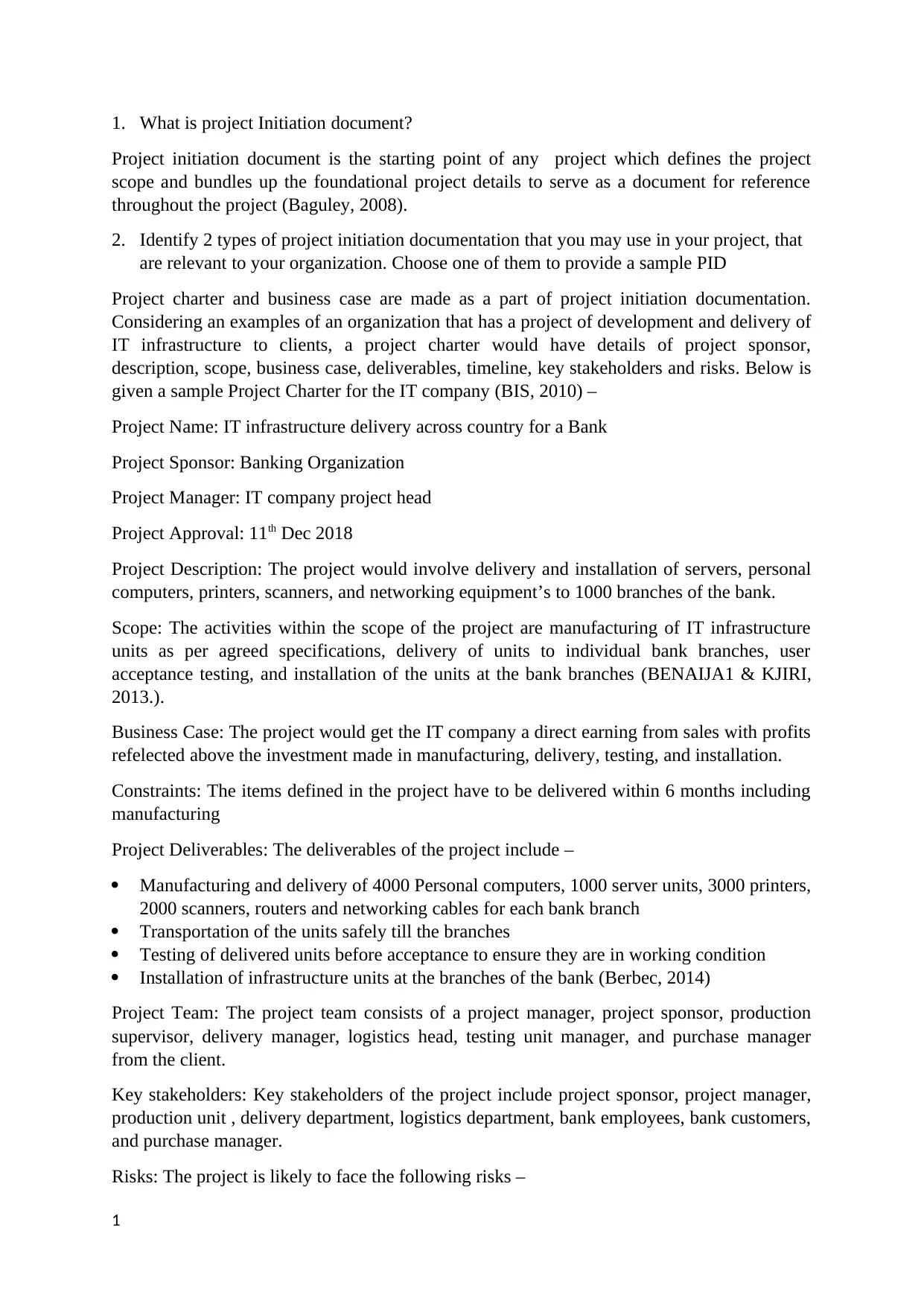
1. What is project Initiation document?
Project initiation document is the starting point of any project which defines the project
scope and bundles up the foundational project details to serve as a document for reference
throughout the project (Baguley, 2008).
2. Identify 2 types of project initiation documentation that you may use in your project, that
are relevant to your organization. Choose one of them to provide a sample PID
Project charter and business case are made as a part of project initiation documentation.
Considering an examples of an organization that has a project of development and delivery of
IT infrastructure to clients, a project charter would have details of project sponsor,
description, scope, business case, deliverables, timeline, key stakeholders and risks. Below is
given a sample Project Charter for the IT company (BIS, 2010) –
Project Name: IT infrastructure delivery across country for a Bank
Project Sponsor: Banking Organization
Project Manager: IT company project head
Project Approval: 11th Dec 2018
Project Description: The project would involve delivery and installation of servers, personal
computers, printers, scanners, and networking equipment’s to 1000 branches of the bank.
Scope: The activities within the scope of the project are manufacturing of IT infrastructure
units as per agreed specifications, delivery of units to individual bank branches, user
acceptance testing, and installation of the units at the bank branches (BENAIJA1 & KJIRI,
2013.).
Business Case: The project would get the IT company a direct earning from sales with profits
refelected above the investment made in manufacturing, delivery, testing, and installation.
Constraints: The items defined in the project have to be delivered within 6 months including
manufacturing
Project Deliverables: The deliverables of the project include –
Manufacturing and delivery of 4000 Personal computers, 1000 server units, 3000 printers,
2000 scanners, routers and networking cables for each bank branch
Transportation of the units safely till the branches
Testing of delivered units before acceptance to ensure they are in working condition
Installation of infrastructure units at the branches of the bank (Berbec, 2014)
Project Team: The project team consists of a project manager, project sponsor, production
supervisor, delivery manager, logistics head, testing unit manager, and purchase manager
from the client.
Key stakeholders: Key stakeholders of the project include project sponsor, project manager,
production unit , delivery department, logistics department, bank employees, bank customers,
and purchase manager.
Risks: The project is likely to face the following risks –
1
Project initiation document is the starting point of any project which defines the project
scope and bundles up the foundational project details to serve as a document for reference
throughout the project (Baguley, 2008).
2. Identify 2 types of project initiation documentation that you may use in your project, that
are relevant to your organization. Choose one of them to provide a sample PID
Project charter and business case are made as a part of project initiation documentation.
Considering an examples of an organization that has a project of development and delivery of
IT infrastructure to clients, a project charter would have details of project sponsor,
description, scope, business case, deliverables, timeline, key stakeholders and risks. Below is
given a sample Project Charter for the IT company (BIS, 2010) –
Project Name: IT infrastructure delivery across country for a Bank
Project Sponsor: Banking Organization
Project Manager: IT company project head
Project Approval: 11th Dec 2018
Project Description: The project would involve delivery and installation of servers, personal
computers, printers, scanners, and networking equipment’s to 1000 branches of the bank.
Scope: The activities within the scope of the project are manufacturing of IT infrastructure
units as per agreed specifications, delivery of units to individual bank branches, user
acceptance testing, and installation of the units at the bank branches (BENAIJA1 & KJIRI,
2013.).
Business Case: The project would get the IT company a direct earning from sales with profits
refelected above the investment made in manufacturing, delivery, testing, and installation.
Constraints: The items defined in the project have to be delivered within 6 months including
manufacturing
Project Deliverables: The deliverables of the project include –
Manufacturing and delivery of 4000 Personal computers, 1000 server units, 3000 printers,
2000 scanners, routers and networking cables for each bank branch
Transportation of the units safely till the branches
Testing of delivered units before acceptance to ensure they are in working condition
Installation of infrastructure units at the branches of the bank (Berbec, 2014)
Project Team: The project team consists of a project manager, project sponsor, production
supervisor, delivery manager, logistics head, testing unit manager, and purchase manager
from the client.
Key stakeholders: Key stakeholders of the project include project sponsor, project manager,
production unit , delivery department, logistics department, bank employees, bank customers,
and purchase manager.
Risks: The project is likely to face the following risks –
1
Secure Best Marks with AI Grader
Need help grading? Try our AI Grader for instant feedback on your assignments.
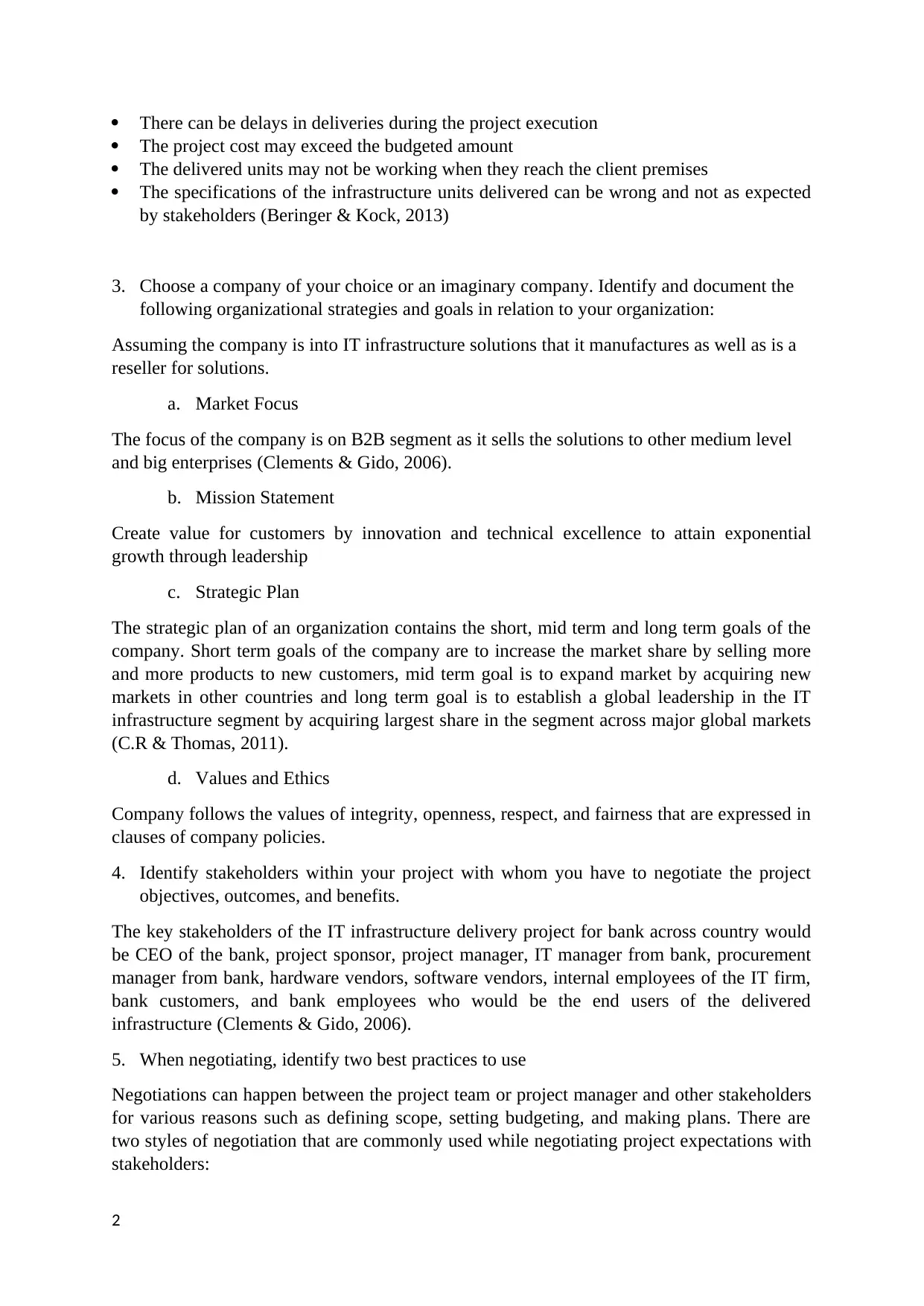
There can be delays in deliveries during the project execution
The project cost may exceed the budgeted amount
The delivered units may not be working when they reach the client premises
The specifications of the infrastructure units delivered can be wrong and not as expected
by stakeholders (Beringer & Kock, 2013)
3. Choose a company of your choice or an imaginary company. Identify and document the
following organizational strategies and goals in relation to your organization:
Assuming the company is into IT infrastructure solutions that it manufactures as well as is a
reseller for solutions.
a. Market Focus
The focus of the company is on B2B segment as it sells the solutions to other medium level
and big enterprises (Clements & Gido, 2006).
b. Mission Statement
Create value for customers by innovation and technical excellence to attain exponential
growth through leadership
c. Strategic Plan
The strategic plan of an organization contains the short, mid term and long term goals of the
company. Short term goals of the company are to increase the market share by selling more
and more products to new customers, mid term goal is to expand market by acquiring new
markets in other countries and long term goal is to establish a global leadership in the IT
infrastructure segment by acquiring largest share in the segment across major global markets
(C.R & Thomas, 2011).
d. Values and Ethics
Company follows the values of integrity, openness, respect, and fairness that are expressed in
clauses of company policies.
4. Identify stakeholders within your project with whom you have to negotiate the project
objectives, outcomes, and benefits.
The key stakeholders of the IT infrastructure delivery project for bank across country would
be CEO of the bank, project sponsor, project manager, IT manager from bank, procurement
manager from bank, hardware vendors, software vendors, internal employees of the IT firm,
bank customers, and bank employees who would be the end users of the delivered
infrastructure (Clements & Gido, 2006).
5. When negotiating, identify two best practices to use
Negotiations can happen between the project team or project manager and other stakeholders
for various reasons such as defining scope, setting budgeting, and making plans. There are
two styles of negotiation that are commonly used while negotiating project expectations with
stakeholders:
2
The project cost may exceed the budgeted amount
The delivered units may not be working when they reach the client premises
The specifications of the infrastructure units delivered can be wrong and not as expected
by stakeholders (Beringer & Kock, 2013)
3. Choose a company of your choice or an imaginary company. Identify and document the
following organizational strategies and goals in relation to your organization:
Assuming the company is into IT infrastructure solutions that it manufactures as well as is a
reseller for solutions.
a. Market Focus
The focus of the company is on B2B segment as it sells the solutions to other medium level
and big enterprises (Clements & Gido, 2006).
b. Mission Statement
Create value for customers by innovation and technical excellence to attain exponential
growth through leadership
c. Strategic Plan
The strategic plan of an organization contains the short, mid term and long term goals of the
company. Short term goals of the company are to increase the market share by selling more
and more products to new customers, mid term goal is to expand market by acquiring new
markets in other countries and long term goal is to establish a global leadership in the IT
infrastructure segment by acquiring largest share in the segment across major global markets
(C.R & Thomas, 2011).
d. Values and Ethics
Company follows the values of integrity, openness, respect, and fairness that are expressed in
clauses of company policies.
4. Identify stakeholders within your project with whom you have to negotiate the project
objectives, outcomes, and benefits.
The key stakeholders of the IT infrastructure delivery project for bank across country would
be CEO of the bank, project sponsor, project manager, IT manager from bank, procurement
manager from bank, hardware vendors, software vendors, internal employees of the IT firm,
bank customers, and bank employees who would be the end users of the delivered
infrastructure (Clements & Gido, 2006).
5. When negotiating, identify two best practices to use
Negotiations can happen between the project team or project manager and other stakeholders
for various reasons such as defining scope, setting budgeting, and making plans. There are
two styles of negotiation that are commonly used while negotiating project expectations with
stakeholders:
2
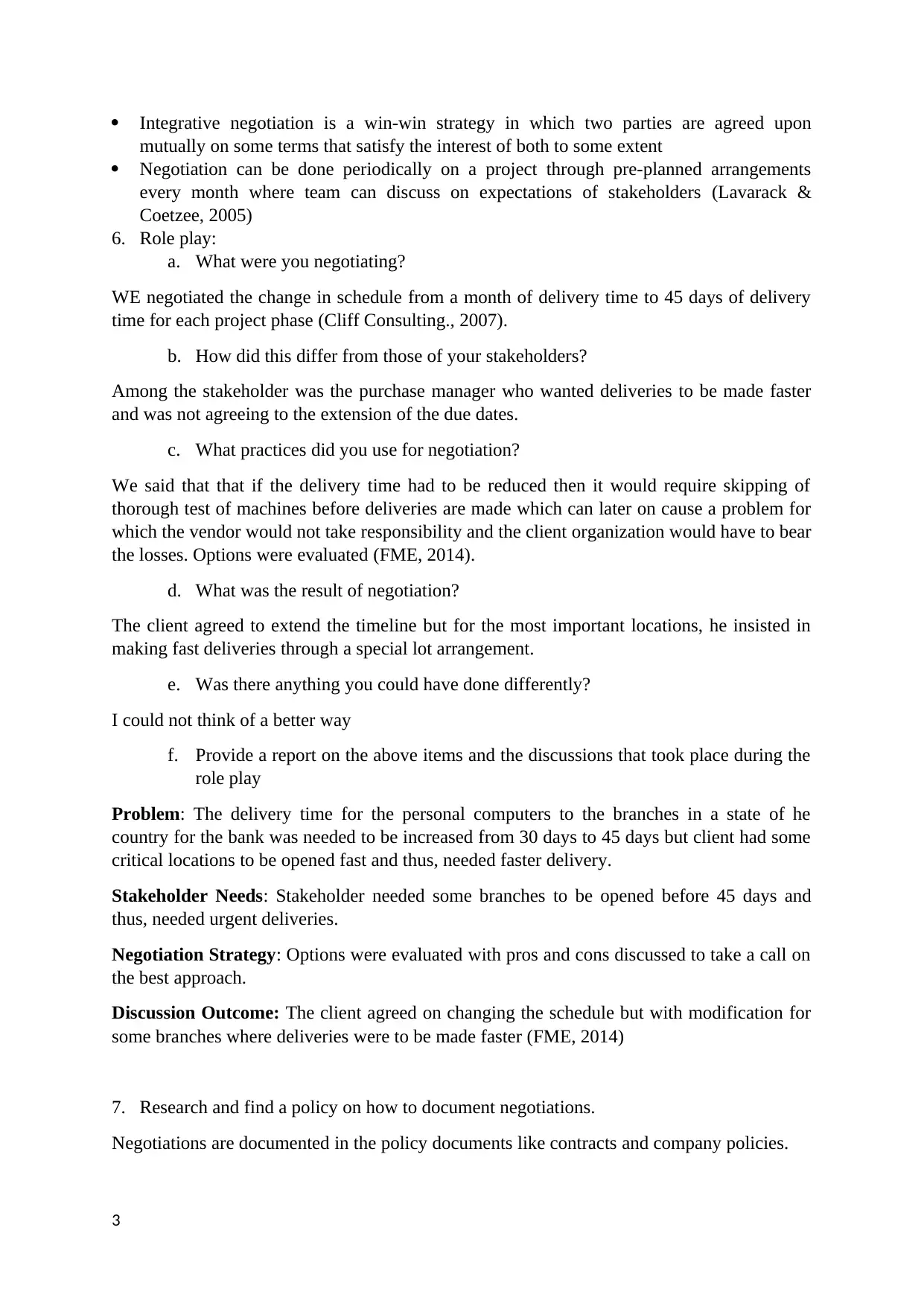
Integrative negotiation is a win-win strategy in which two parties are agreed upon
mutually on some terms that satisfy the interest of both to some extent
Negotiation can be done periodically on a project through pre-planned arrangements
every month where team can discuss on expectations of stakeholders (Lavarack &
Coetzee, 2005)
6. Role play:
a. What were you negotiating?
WE negotiated the change in schedule from a month of delivery time to 45 days of delivery
time for each project phase (Cliff Consulting., 2007).
b. How did this differ from those of your stakeholders?
Among the stakeholder was the purchase manager who wanted deliveries to be made faster
and was not agreeing to the extension of the due dates.
c. What practices did you use for negotiation?
We said that that if the delivery time had to be reduced then it would require skipping of
thorough test of machines before deliveries are made which can later on cause a problem for
which the vendor would not take responsibility and the client organization would have to bear
the losses. Options were evaluated (FME, 2014).
d. What was the result of negotiation?
The client agreed to extend the timeline but for the most important locations, he insisted in
making fast deliveries through a special lot arrangement.
e. Was there anything you could have done differently?
I could not think of a better way
f. Provide a report on the above items and the discussions that took place during the
role play
Problem: The delivery time for the personal computers to the branches in a state of he
country for the bank was needed to be increased from 30 days to 45 days but client had some
critical locations to be opened fast and thus, needed faster delivery.
Stakeholder Needs: Stakeholder needed some branches to be opened before 45 days and
thus, needed urgent deliveries.
Negotiation Strategy: Options were evaluated with pros and cons discussed to take a call on
the best approach.
Discussion Outcome: The client agreed on changing the schedule but with modification for
some branches where deliveries were to be made faster (FME, 2014)
7. Research and find a policy on how to document negotiations.
Negotiations are documented in the policy documents like contracts and company policies.
3
mutually on some terms that satisfy the interest of both to some extent
Negotiation can be done periodically on a project through pre-planned arrangements
every month where team can discuss on expectations of stakeholders (Lavarack &
Coetzee, 2005)
6. Role play:
a. What were you negotiating?
WE negotiated the change in schedule from a month of delivery time to 45 days of delivery
time for each project phase (Cliff Consulting., 2007).
b. How did this differ from those of your stakeholders?
Among the stakeholder was the purchase manager who wanted deliveries to be made faster
and was not agreeing to the extension of the due dates.
c. What practices did you use for negotiation?
We said that that if the delivery time had to be reduced then it would require skipping of
thorough test of machines before deliveries are made which can later on cause a problem for
which the vendor would not take responsibility and the client organization would have to bear
the losses. Options were evaluated (FME, 2014).
d. What was the result of negotiation?
The client agreed to extend the timeline but for the most important locations, he insisted in
making fast deliveries through a special lot arrangement.
e. Was there anything you could have done differently?
I could not think of a better way
f. Provide a report on the above items and the discussions that took place during the
role play
Problem: The delivery time for the personal computers to the branches in a state of he
country for the bank was needed to be increased from 30 days to 45 days but client had some
critical locations to be opened fast and thus, needed faster delivery.
Stakeholder Needs: Stakeholder needed some branches to be opened before 45 days and
thus, needed urgent deliveries.
Negotiation Strategy: Options were evaluated with pros and cons discussed to take a call on
the best approach.
Discussion Outcome: The client agreed on changing the schedule but with modification for
some branches where deliveries were to be made faster (FME, 2014)
7. Research and find a policy on how to document negotiations.
Negotiations are documented in the policy documents like contracts and company policies.
3
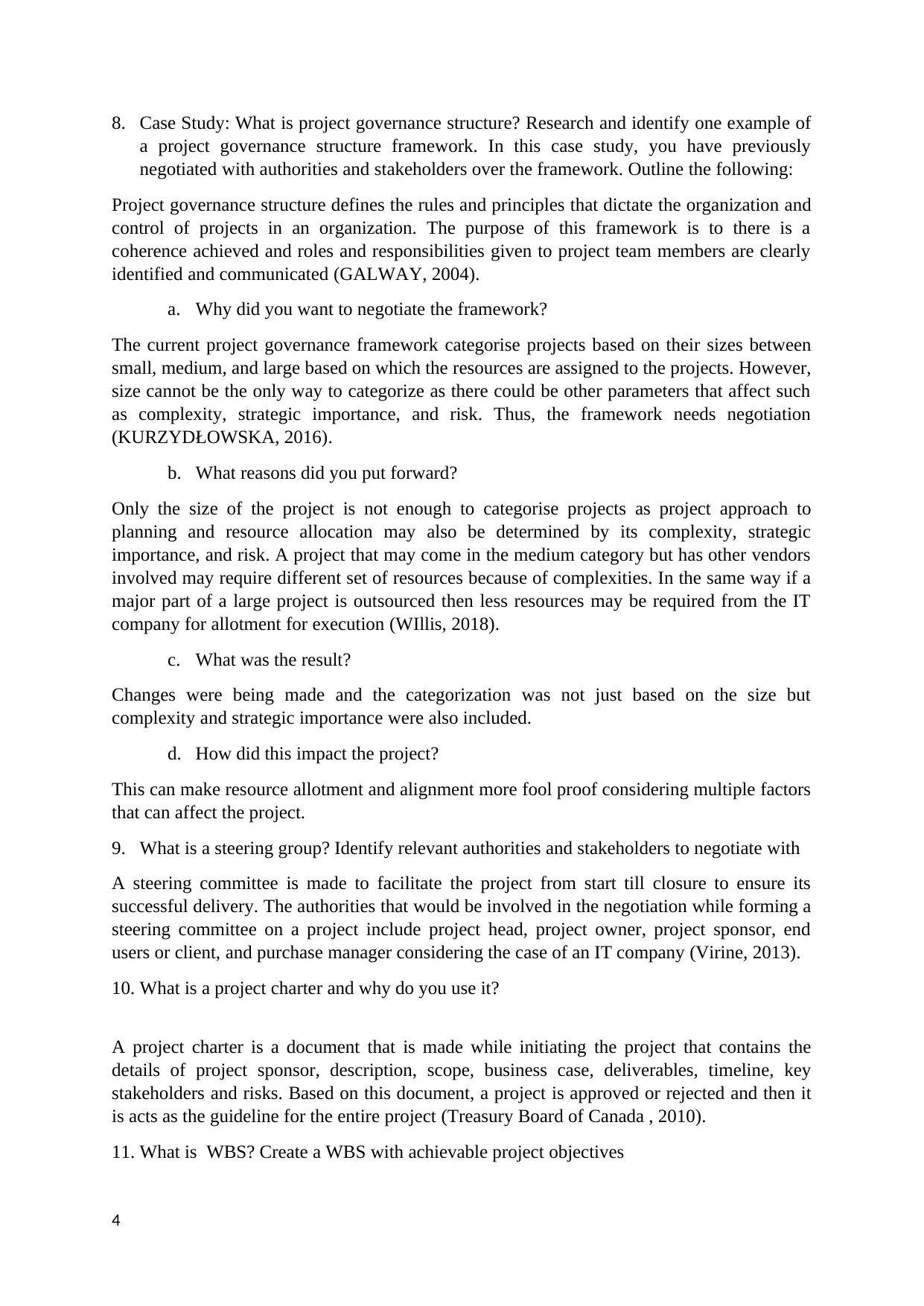
8. Case Study: What is project governance structure? Research and identify one example of
a project governance structure framework. In this case study, you have previously
negotiated with authorities and stakeholders over the framework. Outline the following:
Project governance structure defines the rules and principles that dictate the organization and
control of projects in an organization. The purpose of this framework is to there is a
coherence achieved and roles and responsibilities given to project team members are clearly
identified and communicated (GALWAY, 2004).
a. Why did you want to negotiate the framework?
The current project governance framework categorise projects based on their sizes between
small, medium, and large based on which the resources are assigned to the projects. However,
size cannot be the only way to categorize as there could be other parameters that affect such
as complexity, strategic importance, and risk. Thus, the framework needs negotiation
(KURZYDŁOWSKA, 2016).
b. What reasons did you put forward?
Only the size of the project is not enough to categorise projects as project approach to
planning and resource allocation may also be determined by its complexity, strategic
importance, and risk. A project that may come in the medium category but has other vendors
involved may require different set of resources because of complexities. In the same way if a
major part of a large project is outsourced then less resources may be required from the IT
company for allotment for execution (WIllis, 2018).
c. What was the result?
Changes were being made and the categorization was not just based on the size but
complexity and strategic importance were also included.
d. How did this impact the project?
This can make resource allotment and alignment more fool proof considering multiple factors
that can affect the project.
9. What is a steering group? Identify relevant authorities and stakeholders to negotiate with
A steering committee is made to facilitate the project from start till closure to ensure its
successful delivery. The authorities that would be involved in the negotiation while forming a
steering committee on a project include project head, project owner, project sponsor, end
users or client, and purchase manager considering the case of an IT company (Virine, 2013).
10. What is a project charter and why do you use it?
A project charter is a document that is made while initiating the project that contains the
details of project sponsor, description, scope, business case, deliverables, timeline, key
stakeholders and risks. Based on this document, a project is approved or rejected and then it
is acts as the guideline for the entire project (Treasury Board of Canada , 2010).
11. What is WBS? Create a WBS with achievable project objectives
4
a project governance structure framework. In this case study, you have previously
negotiated with authorities and stakeholders over the framework. Outline the following:
Project governance structure defines the rules and principles that dictate the organization and
control of projects in an organization. The purpose of this framework is to there is a
coherence achieved and roles and responsibilities given to project team members are clearly
identified and communicated (GALWAY, 2004).
a. Why did you want to negotiate the framework?
The current project governance framework categorise projects based on their sizes between
small, medium, and large based on which the resources are assigned to the projects. However,
size cannot be the only way to categorize as there could be other parameters that affect such
as complexity, strategic importance, and risk. Thus, the framework needs negotiation
(KURZYDŁOWSKA, 2016).
b. What reasons did you put forward?
Only the size of the project is not enough to categorise projects as project approach to
planning and resource allocation may also be determined by its complexity, strategic
importance, and risk. A project that may come in the medium category but has other vendors
involved may require different set of resources because of complexities. In the same way if a
major part of a large project is outsourced then less resources may be required from the IT
company for allotment for execution (WIllis, 2018).
c. What was the result?
Changes were being made and the categorization was not just based on the size but
complexity and strategic importance were also included.
d. How did this impact the project?
This can make resource allotment and alignment more fool proof considering multiple factors
that can affect the project.
9. What is a steering group? Identify relevant authorities and stakeholders to negotiate with
A steering committee is made to facilitate the project from start till closure to ensure its
successful delivery. The authorities that would be involved in the negotiation while forming a
steering committee on a project include project head, project owner, project sponsor, end
users or client, and purchase manager considering the case of an IT company (Virine, 2013).
10. What is a project charter and why do you use it?
A project charter is a document that is made while initiating the project that contains the
details of project sponsor, description, scope, business case, deliverables, timeline, key
stakeholders and risks. Based on this document, a project is approved or rejected and then it
is acts as the guideline for the entire project (Treasury Board of Canada , 2010).
11. What is WBS? Create a WBS with achievable project objectives
4
Secure Best Marks with AI Grader
Need help grading? Try our AI Grader for instant feedback on your assignments.
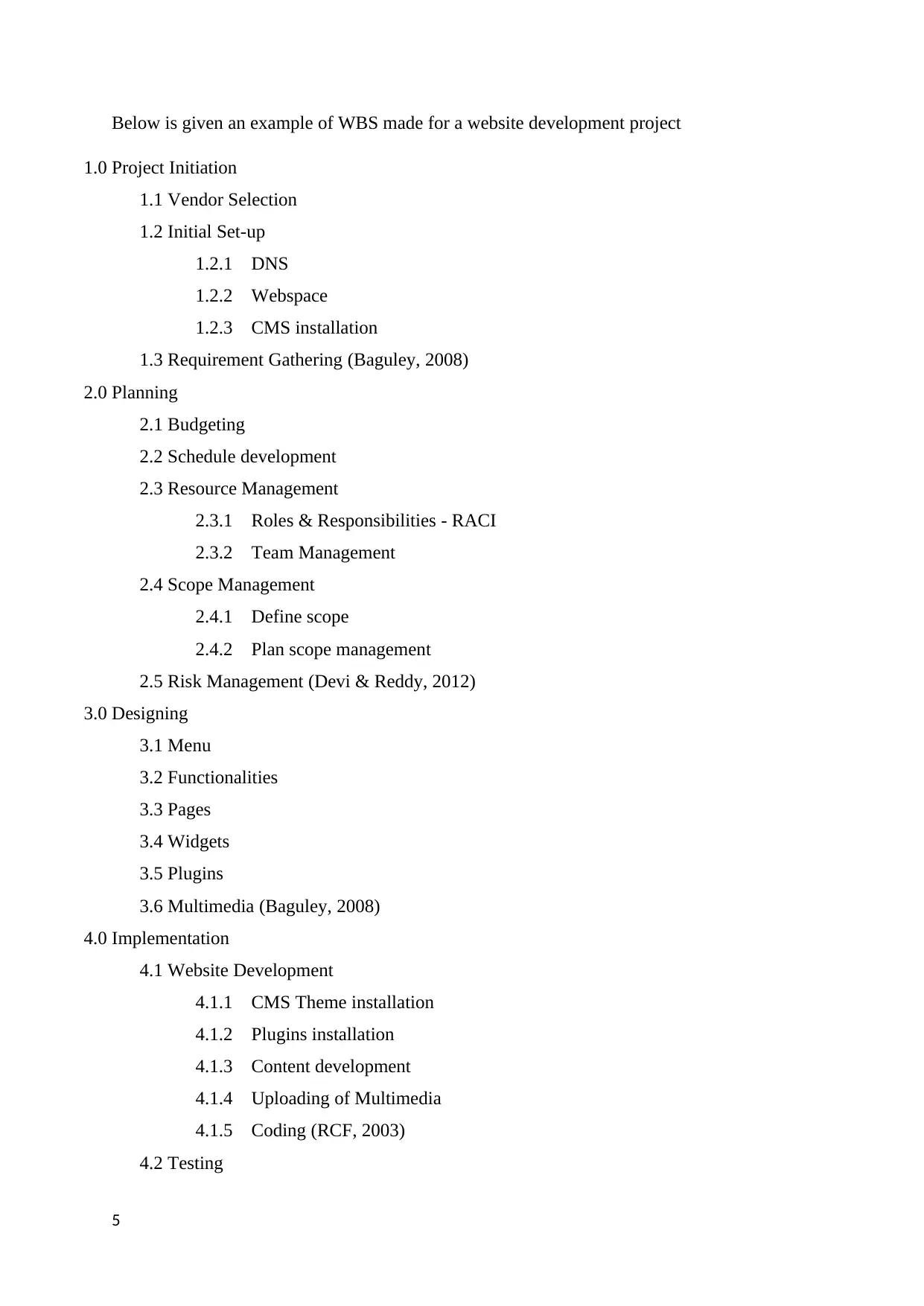
Below is given an example of WBS made for a website development project
1.0 Project Initiation
1.1 Vendor Selection
1.2 Initial Set-up
1.2.1 DNS
1.2.2 Webspace
1.2.3 CMS installation
1.3 Requirement Gathering (Baguley, 2008)
2.0 Planning
2.1 Budgeting
2.2 Schedule development
2.3 Resource Management
2.3.1 Roles & Responsibilities - RACI
2.3.2 Team Management
2.4 Scope Management
2.4.1 Define scope
2.4.2 Plan scope management
2.5 Risk Management (Devi & Reddy, 2012)
3.0 Designing
3.1 Menu
3.2 Functionalities
3.3 Pages
3.4 Widgets
3.5 Plugins
3.6 Multimedia (Baguley, 2008)
4.0 Implementation
4.1 Website Development
4.1.1 CMS Theme installation
4.1.2 Plugins installation
4.1.3 Content development
4.1.4 Uploading of Multimedia
4.1.5 Coding (RCF, 2003)
4.2 Testing
5
1.0 Project Initiation
1.1 Vendor Selection
1.2 Initial Set-up
1.2.1 DNS
1.2.2 Webspace
1.2.3 CMS installation
1.3 Requirement Gathering (Baguley, 2008)
2.0 Planning
2.1 Budgeting
2.2 Schedule development
2.3 Resource Management
2.3.1 Roles & Responsibilities - RACI
2.3.2 Team Management
2.4 Scope Management
2.4.1 Define scope
2.4.2 Plan scope management
2.5 Risk Management (Devi & Reddy, 2012)
3.0 Designing
3.1 Menu
3.2 Functionalities
3.3 Pages
3.4 Widgets
3.5 Plugins
3.6 Multimedia (Baguley, 2008)
4.0 Implementation
4.1 Website Development
4.1.1 CMS Theme installation
4.1.2 Plugins installation
4.1.3 Content development
4.1.4 Uploading of Multimedia
4.1.5 Coding (RCF, 2003)
4.2 Testing
5
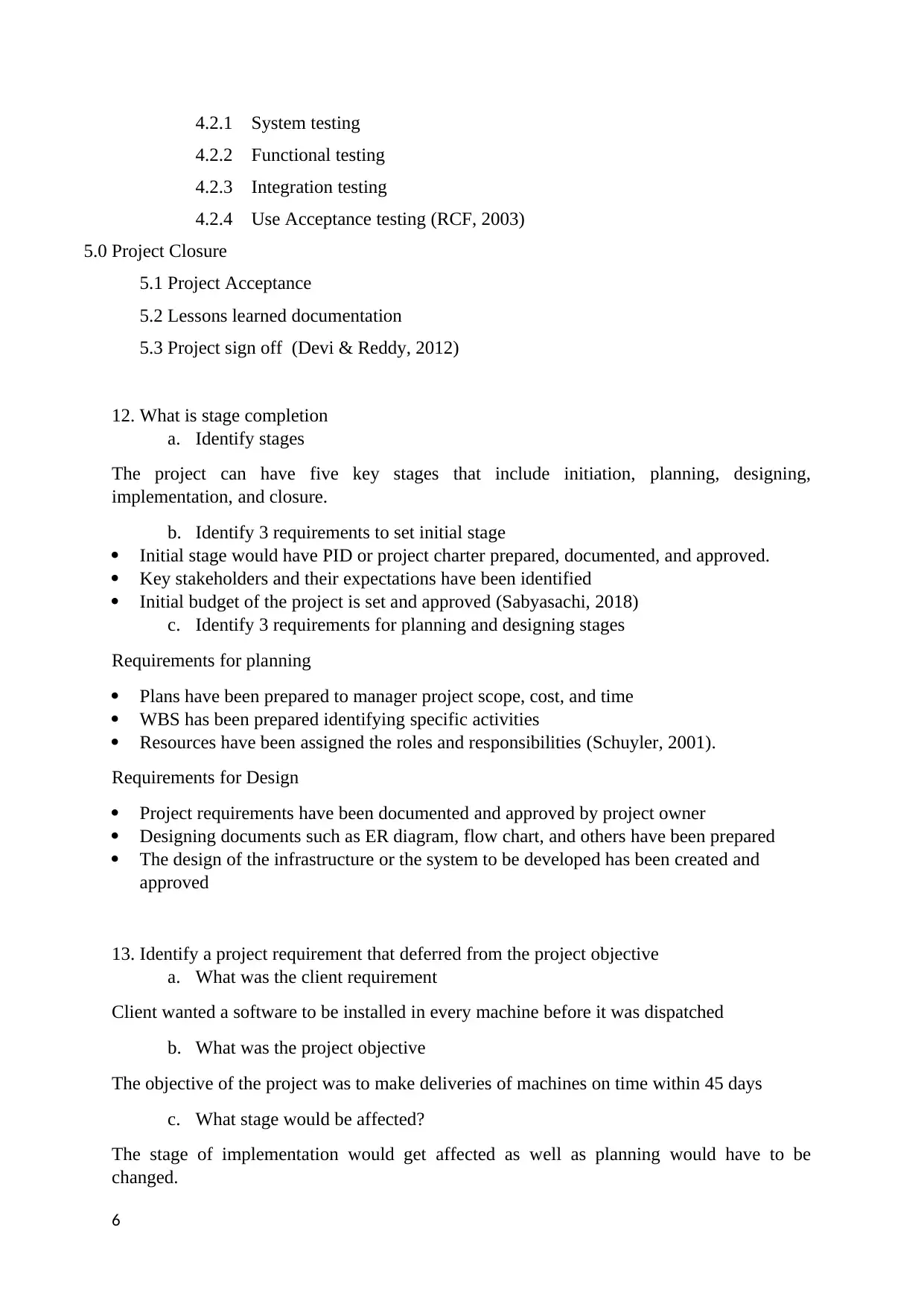
4.2.1 System testing
4.2.2 Functional testing
4.2.3 Integration testing
4.2.4 Use Acceptance testing (RCF, 2003)
5.0 Project Closure
5.1 Project Acceptance
5.2 Lessons learned documentation
5.3 Project sign off (Devi & Reddy, 2012)
12. What is stage completion
a. Identify stages
The project can have five key stages that include initiation, planning, designing,
implementation, and closure.
b. Identify 3 requirements to set initial stage
Initial stage would have PID or project charter prepared, documented, and approved.
Key stakeholders and their expectations have been identified
Initial budget of the project is set and approved (Sabyasachi, 2018)
c. Identify 3 requirements for planning and designing stages
Requirements for planning
Plans have been prepared to manager project scope, cost, and time
WBS has been prepared identifying specific activities
Resources have been assigned the roles and responsibilities (Schuyler, 2001).
Requirements for Design
Project requirements have been documented and approved by project owner
Designing documents such as ER diagram, flow chart, and others have been prepared
The design of the infrastructure or the system to be developed has been created and
approved
13. Identify a project requirement that deferred from the project objective
a. What was the client requirement
Client wanted a software to be installed in every machine before it was dispatched
b. What was the project objective
The objective of the project was to make deliveries of machines on time within 45 days
c. What stage would be affected?
The stage of implementation would get affected as well as planning would have to be
changed.
6
4.2.2 Functional testing
4.2.3 Integration testing
4.2.4 Use Acceptance testing (RCF, 2003)
5.0 Project Closure
5.1 Project Acceptance
5.2 Lessons learned documentation
5.3 Project sign off (Devi & Reddy, 2012)
12. What is stage completion
a. Identify stages
The project can have five key stages that include initiation, planning, designing,
implementation, and closure.
b. Identify 3 requirements to set initial stage
Initial stage would have PID or project charter prepared, documented, and approved.
Key stakeholders and their expectations have been identified
Initial budget of the project is set and approved (Sabyasachi, 2018)
c. Identify 3 requirements for planning and designing stages
Requirements for planning
Plans have been prepared to manager project scope, cost, and time
WBS has been prepared identifying specific activities
Resources have been assigned the roles and responsibilities (Schuyler, 2001).
Requirements for Design
Project requirements have been documented and approved by project owner
Designing documents such as ER diagram, flow chart, and others have been prepared
The design of the infrastructure or the system to be developed has been created and
approved
13. Identify a project requirement that deferred from the project objective
a. What was the client requirement
Client wanted a software to be installed in every machine before it was dispatched
b. What was the project objective
The objective of the project was to make deliveries of machines on time within 45 days
c. What stage would be affected?
The stage of implementation would get affected as well as planning would have to be
changed.
6
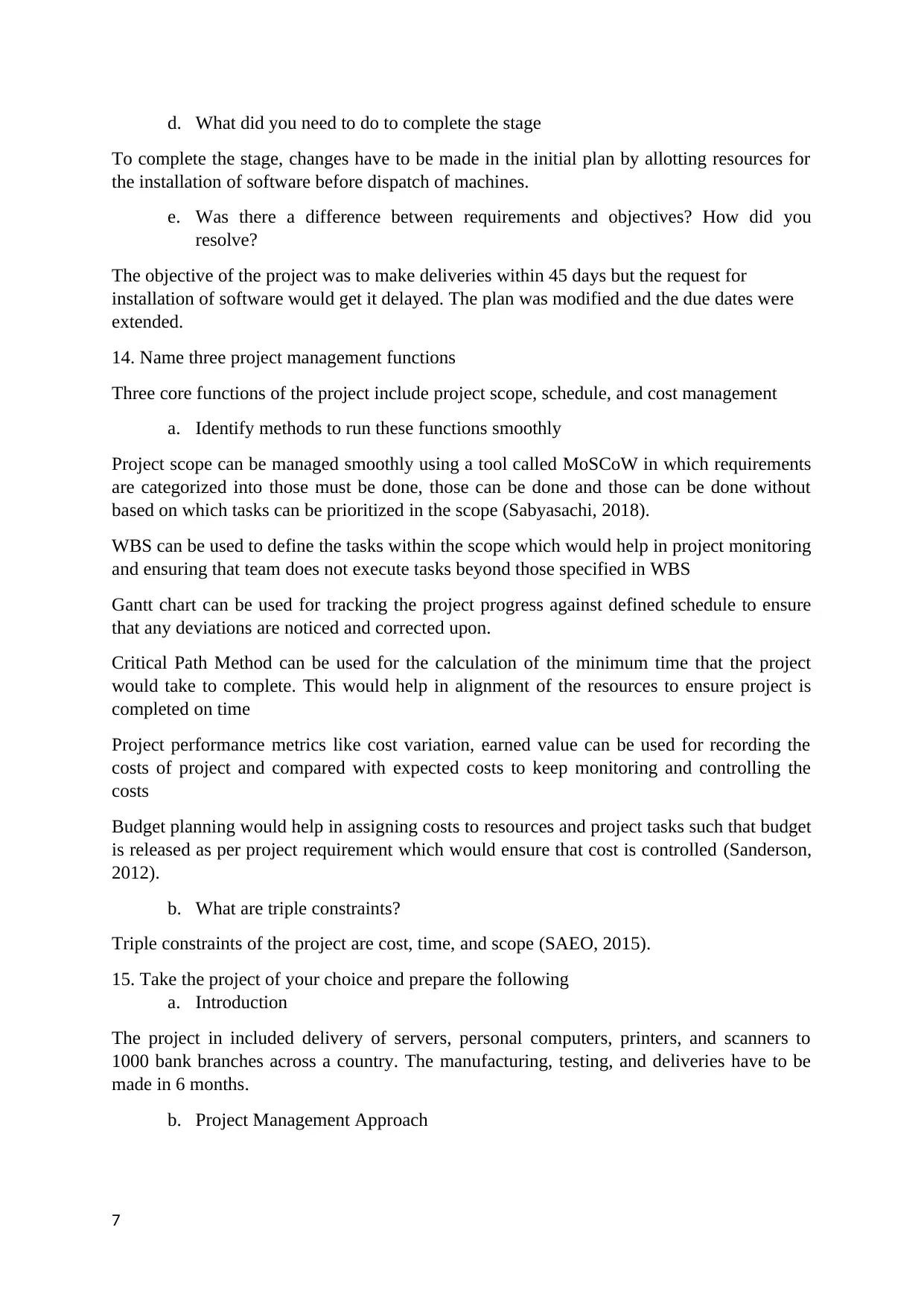
d. What did you need to do to complete the stage
To complete the stage, changes have to be made in the initial plan by allotting resources for
the installation of software before dispatch of machines.
e. Was there a difference between requirements and objectives? How did you
resolve?
The objective of the project was to make deliveries within 45 days but the request for
installation of software would get it delayed. The plan was modified and the due dates were
extended.
14. Name three project management functions
Three core functions of the project include project scope, schedule, and cost management
a. Identify methods to run these functions smoothly
Project scope can be managed smoothly using a tool called MoSCoW in which requirements
are categorized into those must be done, those can be done and those can be done without
based on which tasks can be prioritized in the scope (Sabyasachi, 2018).
WBS can be used to define the tasks within the scope which would help in project monitoring
and ensuring that team does not execute tasks beyond those specified in WBS
Gantt chart can be used for tracking the project progress against defined schedule to ensure
that any deviations are noticed and corrected upon.
Critical Path Method can be used for the calculation of the minimum time that the project
would take to complete. This would help in alignment of the resources to ensure project is
completed on time
Project performance metrics like cost variation, earned value can be used for recording the
costs of project and compared with expected costs to keep monitoring and controlling the
costs
Budget planning would help in assigning costs to resources and project tasks such that budget
is released as per project requirement which would ensure that cost is controlled (Sanderson,
2012).
b. What are triple constraints?
Triple constraints of the project are cost, time, and scope (SAEO, 2015).
15. Take the project of your choice and prepare the following
a. Introduction
The project in included delivery of servers, personal computers, printers, and scanners to
1000 bank branches across a country. The manufacturing, testing, and deliveries have to be
made in 6 months.
b. Project Management Approach
7
To complete the stage, changes have to be made in the initial plan by allotting resources for
the installation of software before dispatch of machines.
e. Was there a difference between requirements and objectives? How did you
resolve?
The objective of the project was to make deliveries within 45 days but the request for
installation of software would get it delayed. The plan was modified and the due dates were
extended.
14. Name three project management functions
Three core functions of the project include project scope, schedule, and cost management
a. Identify methods to run these functions smoothly
Project scope can be managed smoothly using a tool called MoSCoW in which requirements
are categorized into those must be done, those can be done and those can be done without
based on which tasks can be prioritized in the scope (Sabyasachi, 2018).
WBS can be used to define the tasks within the scope which would help in project monitoring
and ensuring that team does not execute tasks beyond those specified in WBS
Gantt chart can be used for tracking the project progress against defined schedule to ensure
that any deviations are noticed and corrected upon.
Critical Path Method can be used for the calculation of the minimum time that the project
would take to complete. This would help in alignment of the resources to ensure project is
completed on time
Project performance metrics like cost variation, earned value can be used for recording the
costs of project and compared with expected costs to keep monitoring and controlling the
costs
Budget planning would help in assigning costs to resources and project tasks such that budget
is released as per project requirement which would ensure that cost is controlled (Sanderson,
2012).
b. What are triple constraints?
Triple constraints of the project are cost, time, and scope (SAEO, 2015).
15. Take the project of your choice and prepare the following
a. Introduction
The project in included delivery of servers, personal computers, printers, and scanners to
1000 bank branches across a country. The manufacturing, testing, and deliveries have to be
made in 6 months.
b. Project Management Approach
7
Paraphrase This Document
Need a fresh take? Get an instant paraphrase of this document with our AI Paraphraser

PMBOK project management methodology was used for the management of the project
which followed the stages of initiation, planning, execution, monitoring and control, and
closure.
c. Project scope
Project scope included:
Manufacturing of personal computers and servers as per required specifications
Procurement of printers and scanners as required
Testing of personal computers and servers before dispatch
Delivery of personal computers, servers, scanners, and printers to bank premises
d. Milestone list
Milestones of the project included:
Manufacturing of personal computers
Manufacturing of servers
Testing of computers
Testing of servers
Dispatch of machines to warehouse
Procurement of scanners and printers from vendors
Dispatch of printers and scanners to warehouse
Dispatch of machines to bank branches
User acceptance testing
e. Schedule baseline and WBS
The project had to be completed in 6 months which included 4 months of manufacturing and
procurement, 1 month of dispatch to warehouse and testing of machines and one month for
delivery to bank branches (SAEO, 2015).
WBS:
6.0 Project Initiation
6.1 Vendor Selection
6.2 Procurement
6.2.1 Printers
6.2.2 Scanners
6.3 Requirement Gathering (Baguley, 2008)
7.0 Planning
7.1 Budgeting
7.2 Schedule development
7.3 Resource Management
7.3.1 Roles & Responsibilities - RACI
7.3.2 Team Management
8
which followed the stages of initiation, planning, execution, monitoring and control, and
closure.
c. Project scope
Project scope included:
Manufacturing of personal computers and servers as per required specifications
Procurement of printers and scanners as required
Testing of personal computers and servers before dispatch
Delivery of personal computers, servers, scanners, and printers to bank premises
d. Milestone list
Milestones of the project included:
Manufacturing of personal computers
Manufacturing of servers
Testing of computers
Testing of servers
Dispatch of machines to warehouse
Procurement of scanners and printers from vendors
Dispatch of printers and scanners to warehouse
Dispatch of machines to bank branches
User acceptance testing
e. Schedule baseline and WBS
The project had to be completed in 6 months which included 4 months of manufacturing and
procurement, 1 month of dispatch to warehouse and testing of machines and one month for
delivery to bank branches (SAEO, 2015).
WBS:
6.0 Project Initiation
6.1 Vendor Selection
6.2 Procurement
6.2.1 Printers
6.2.2 Scanners
6.3 Requirement Gathering (Baguley, 2008)
7.0 Planning
7.1 Budgeting
7.2 Schedule development
7.3 Resource Management
7.3.1 Roles & Responsibilities - RACI
7.3.2 Team Management
8
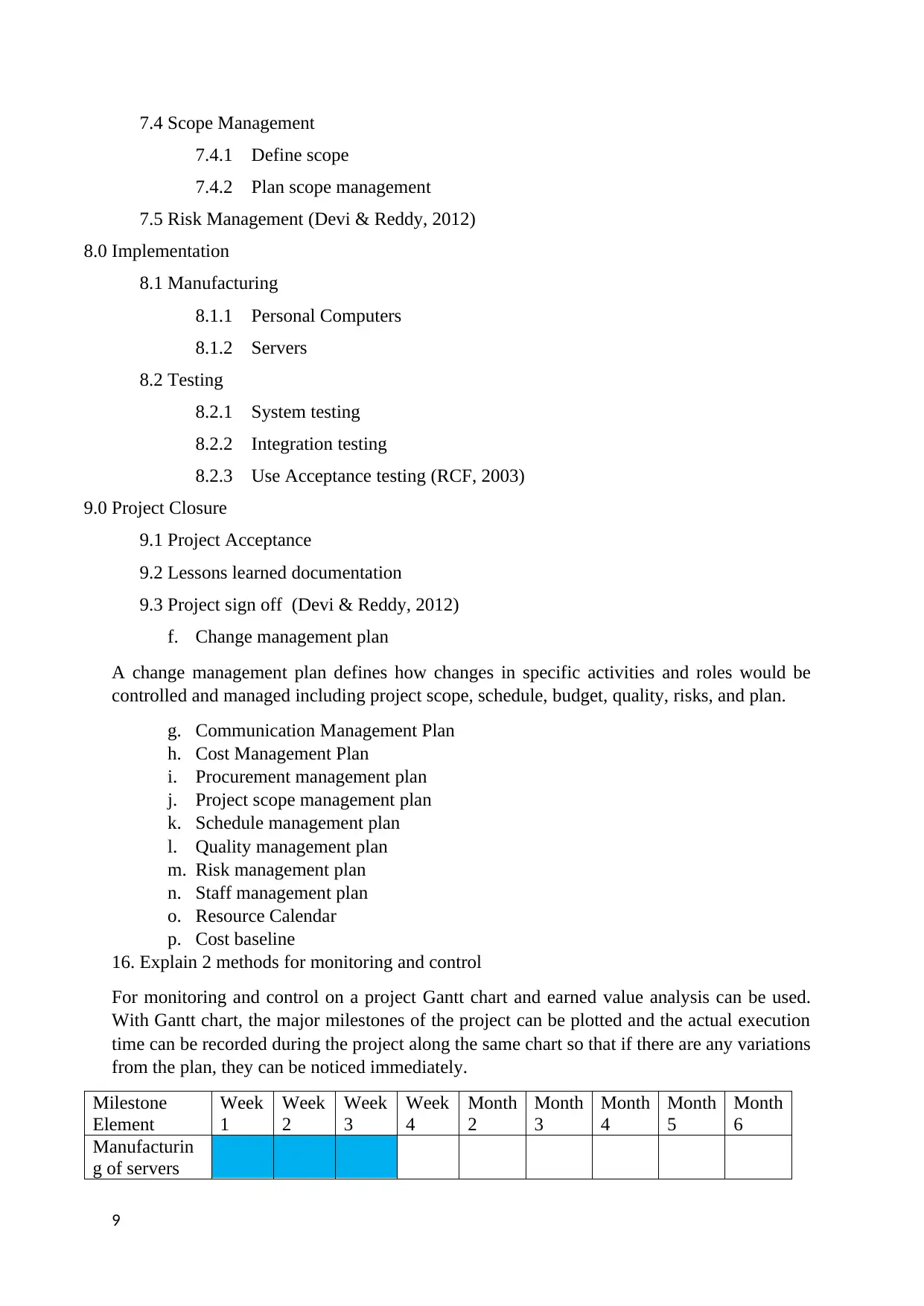
7.4 Scope Management
7.4.1 Define scope
7.4.2 Plan scope management
7.5 Risk Management (Devi & Reddy, 2012)
8.0 Implementation
8.1 Manufacturing
8.1.1 Personal Computers
8.1.2 Servers
8.2 Testing
8.2.1 System testing
8.2.2 Integration testing
8.2.3 Use Acceptance testing (RCF, 2003)
9.0 Project Closure
9.1 Project Acceptance
9.2 Lessons learned documentation
9.3 Project sign off (Devi & Reddy, 2012)
f. Change management plan
A change management plan defines how changes in specific activities and roles would be
controlled and managed including project scope, schedule, budget, quality, risks, and plan.
g. Communication Management Plan
h. Cost Management Plan
i. Procurement management plan
j. Project scope management plan
k. Schedule management plan
l. Quality management plan
m. Risk management plan
n. Staff management plan
o. Resource Calendar
p. Cost baseline
16. Explain 2 methods for monitoring and control
For monitoring and control on a project Gantt chart and earned value analysis can be used.
With Gantt chart, the major milestones of the project can be plotted and the actual execution
time can be recorded during the project along the same chart so that if there are any variations
from the plan, they can be noticed immediately.
Milestone
Element
Week
1
Week
2
Week
3
Week
4
Month
2
Month
3
Month
4
Month
5
Month
6
Manufacturin
g of servers
9
7.4.1 Define scope
7.4.2 Plan scope management
7.5 Risk Management (Devi & Reddy, 2012)
8.0 Implementation
8.1 Manufacturing
8.1.1 Personal Computers
8.1.2 Servers
8.2 Testing
8.2.1 System testing
8.2.2 Integration testing
8.2.3 Use Acceptance testing (RCF, 2003)
9.0 Project Closure
9.1 Project Acceptance
9.2 Lessons learned documentation
9.3 Project sign off (Devi & Reddy, 2012)
f. Change management plan
A change management plan defines how changes in specific activities and roles would be
controlled and managed including project scope, schedule, budget, quality, risks, and plan.
g. Communication Management Plan
h. Cost Management Plan
i. Procurement management plan
j. Project scope management plan
k. Schedule management plan
l. Quality management plan
m. Risk management plan
n. Staff management plan
o. Resource Calendar
p. Cost baseline
16. Explain 2 methods for monitoring and control
For monitoring and control on a project Gantt chart and earned value analysis can be used.
With Gantt chart, the major milestones of the project can be plotted and the actual execution
time can be recorded during the project along the same chart so that if there are any variations
from the plan, they can be noticed immediately.
Milestone
Element
Week
1
Week
2
Week
3
Week
4
Month
2
Month
3
Month
4
Month
5
Month
6
Manufacturin
g of servers
9
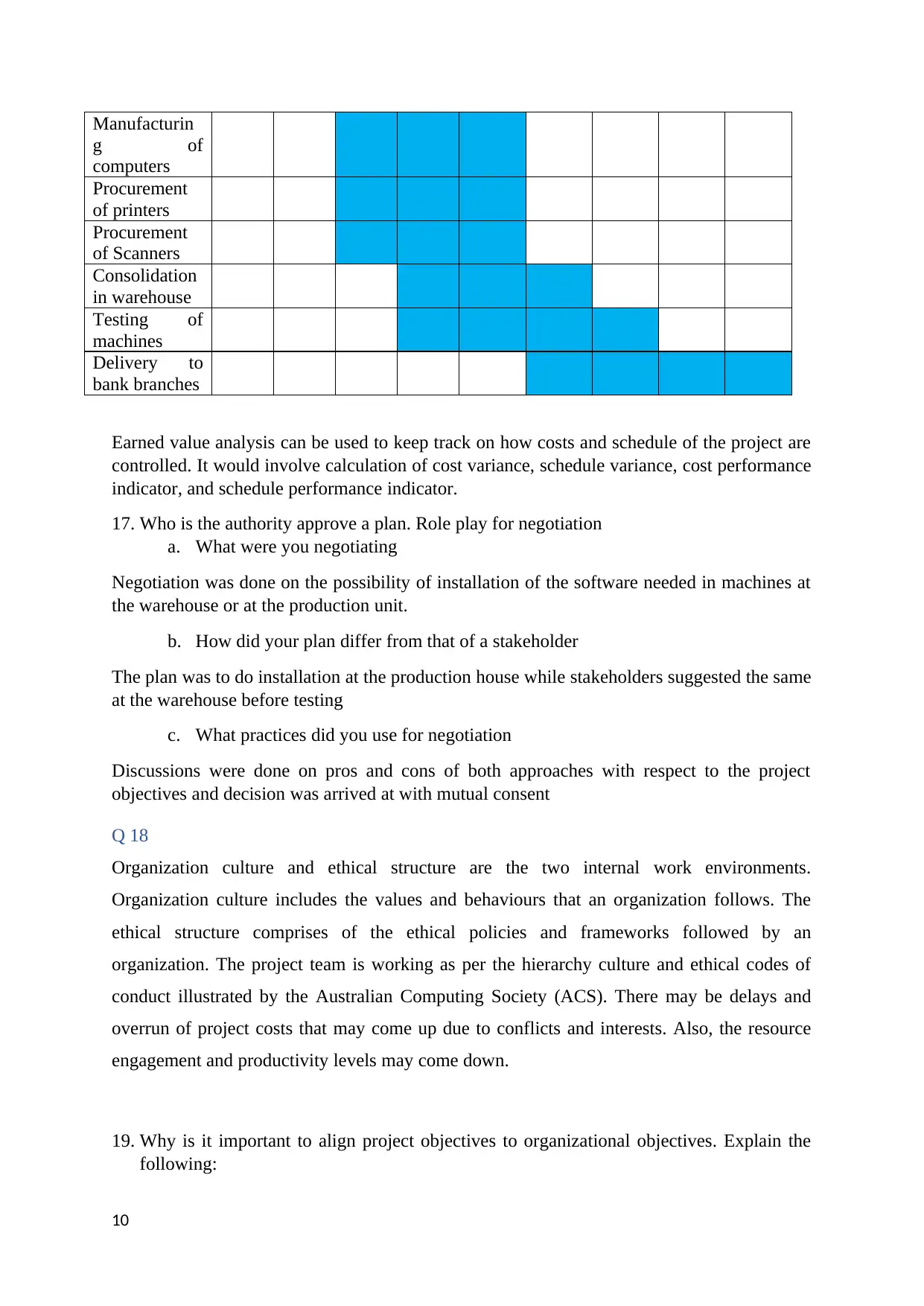
Manufacturin
g of
computers
Procurement
of printers
Procurement
of Scanners
Consolidation
in warehouse
Testing of
machines
Delivery to
bank branches
Earned value analysis can be used to keep track on how costs and schedule of the project are
controlled. It would involve calculation of cost variance, schedule variance, cost performance
indicator, and schedule performance indicator.
17. Who is the authority approve a plan. Role play for negotiation
a. What were you negotiating
Negotiation was done on the possibility of installation of the software needed in machines at
the warehouse or at the production unit.
b. How did your plan differ from that of a stakeholder
The plan was to do installation at the production house while stakeholders suggested the same
at the warehouse before testing
c. What practices did you use for negotiation
Discussions were done on pros and cons of both approaches with respect to the project
objectives and decision was arrived at with mutual consent
Q 18
Organization culture and ethical structure are the two internal work environments.
Organization culture includes the values and behaviours that an organization follows. The
ethical structure comprises of the ethical policies and frameworks followed by an
organization. The project team is working as per the hierarchy culture and ethical codes of
conduct illustrated by the Australian Computing Society (ACS). There may be delays and
overrun of project costs that may come up due to conflicts and interests. Also, the resource
engagement and productivity levels may come down.
19. Why is it important to align project objectives to organizational objectives. Explain the
following:
10
g of
computers
Procurement
of printers
Procurement
of Scanners
Consolidation
in warehouse
Testing of
machines
Delivery to
bank branches
Earned value analysis can be used to keep track on how costs and schedule of the project are
controlled. It would involve calculation of cost variance, schedule variance, cost performance
indicator, and schedule performance indicator.
17. Who is the authority approve a plan. Role play for negotiation
a. What were you negotiating
Negotiation was done on the possibility of installation of the software needed in machines at
the warehouse or at the production unit.
b. How did your plan differ from that of a stakeholder
The plan was to do installation at the production house while stakeholders suggested the same
at the warehouse before testing
c. What practices did you use for negotiation
Discussions were done on pros and cons of both approaches with respect to the project
objectives and decision was arrived at with mutual consent
Q 18
Organization culture and ethical structure are the two internal work environments.
Organization culture includes the values and behaviours that an organization follows. The
ethical structure comprises of the ethical policies and frameworks followed by an
organization. The project team is working as per the hierarchy culture and ethical codes of
conduct illustrated by the Australian Computing Society (ACS). There may be delays and
overrun of project costs that may come up due to conflicts and interests. Also, the resource
engagement and productivity levels may come down.
19. Why is it important to align project objectives to organizational objectives. Explain the
following:
10
Secure Best Marks with AI Grader
Need help grading? Try our AI Grader for instant feedback on your assignments.

a. What methods did you use
For aligning project objectives with organizational objectives, project benefits were linked to
the organizational strategies or objectives such that project was approved only when there
was a sizable benefit for the organization.
b. Why did you use this method
This method would ensure that the project benefits were considered before approval and only
after the project was found feasible and profitable for the company, would it go into
execution and thus, there would be no confusion beyond that.
c. How did project and organizational objectives differed?
They did not differ
d. How did you monitor method?
The organizational objectives were documented in policies for selection of project as the
criteria for selection
e. What was the result?
Only the profitable projects were selected in the first place
20. Identify a management system
a. Current status of deliverables
Deliveries of all the personal computers with installed OS
b. Quality targets
All the machines should have positive testing results
c. Quality standards
d. QA reviews
Reviews were taken to ensure that the Quality standards were met
e. QC reviews
Any variations from QA were identified and corrective actions were taken
f. Actions required
A few machines were found to be working slow and thus, need to be replaced.
g. Time frame to complete action
The company was assigned 1 week for reinstallation of the software in machines
h. Current status
Machines have been recalled fir reinstallation at the warehouse.
i. Project management approach
11
For aligning project objectives with organizational objectives, project benefits were linked to
the organizational strategies or objectives such that project was approved only when there
was a sizable benefit for the organization.
b. Why did you use this method
This method would ensure that the project benefits were considered before approval and only
after the project was found feasible and profitable for the company, would it go into
execution and thus, there would be no confusion beyond that.
c. How did project and organizational objectives differed?
They did not differ
d. How did you monitor method?
The organizational objectives were documented in policies for selection of project as the
criteria for selection
e. What was the result?
Only the profitable projects were selected in the first place
20. Identify a management system
a. Current status of deliverables
Deliveries of all the personal computers with installed OS
b. Quality targets
All the machines should have positive testing results
c. Quality standards
d. QA reviews
Reviews were taken to ensure that the Quality standards were met
e. QC reviews
Any variations from QA were identified and corrective actions were taken
f. Actions required
A few machines were found to be working slow and thus, need to be replaced.
g. Time frame to complete action
The company was assigned 1 week for reinstallation of the software in machines
h. Current status
Machines have been recalled fir reinstallation at the warehouse.
i. Project management approach
11
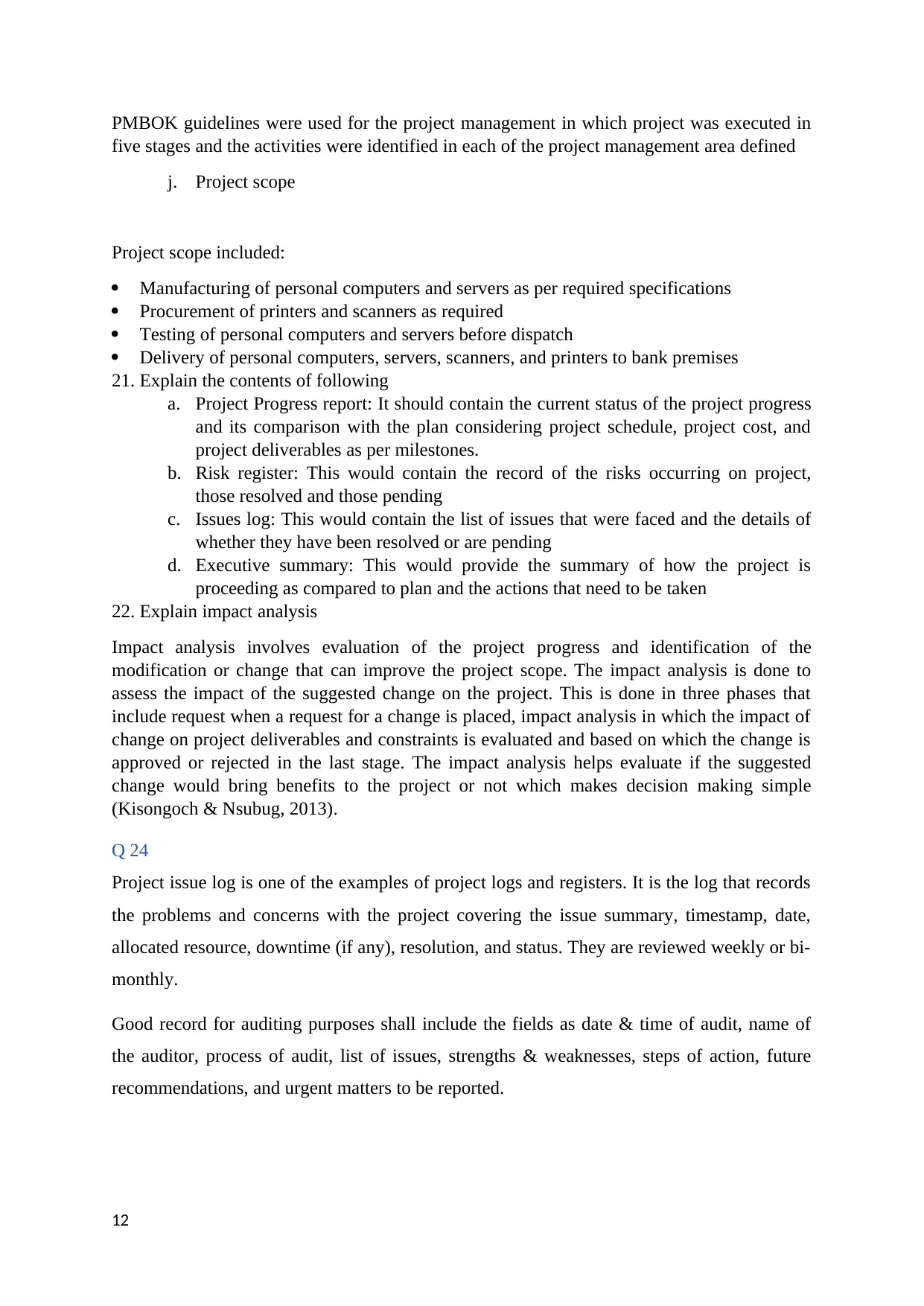
PMBOK guidelines were used for the project management in which project was executed in
five stages and the activities were identified in each of the project management area defined
j. Project scope
Project scope included:
Manufacturing of personal computers and servers as per required specifications
Procurement of printers and scanners as required
Testing of personal computers and servers before dispatch
Delivery of personal computers, servers, scanners, and printers to bank premises
21. Explain the contents of following
a. Project Progress report: It should contain the current status of the project progress
and its comparison with the plan considering project schedule, project cost, and
project deliverables as per milestones.
b. Risk register: This would contain the record of the risks occurring on project,
those resolved and those pending
c. Issues log: This would contain the list of issues that were faced and the details of
whether they have been resolved or are pending
d. Executive summary: This would provide the summary of how the project is
proceeding as compared to plan and the actions that need to be taken
22. Explain impact analysis
Impact analysis involves evaluation of the project progress and identification of the
modification or change that can improve the project scope. The impact analysis is done to
assess the impact of the suggested change on the project. This is done in three phases that
include request when a request for a change is placed, impact analysis in which the impact of
change on project deliverables and constraints is evaluated and based on which the change is
approved or rejected in the last stage. The impact analysis helps evaluate if the suggested
change would bring benefits to the project or not which makes decision making simple
(Kisongoch & Nsubug, 2013).
Q 24
Project issue log is one of the examples of project logs and registers. It is the log that records
the problems and concerns with the project covering the issue summary, timestamp, date,
allocated resource, downtime (if any), resolution, and status. They are reviewed weekly or bi-
monthly.
Good record for auditing purposes shall include the fields as date & time of audit, name of
the auditor, process of audit, list of issues, strengths & weaknesses, steps of action, future
recommendations, and urgent matters to be reported.
12
five stages and the activities were identified in each of the project management area defined
j. Project scope
Project scope included:
Manufacturing of personal computers and servers as per required specifications
Procurement of printers and scanners as required
Testing of personal computers and servers before dispatch
Delivery of personal computers, servers, scanners, and printers to bank premises
21. Explain the contents of following
a. Project Progress report: It should contain the current status of the project progress
and its comparison with the plan considering project schedule, project cost, and
project deliverables as per milestones.
b. Risk register: This would contain the record of the risks occurring on project,
those resolved and those pending
c. Issues log: This would contain the list of issues that were faced and the details of
whether they have been resolved or are pending
d. Executive summary: This would provide the summary of how the project is
proceeding as compared to plan and the actions that need to be taken
22. Explain impact analysis
Impact analysis involves evaluation of the project progress and identification of the
modification or change that can improve the project scope. The impact analysis is done to
assess the impact of the suggested change on the project. This is done in three phases that
include request when a request for a change is placed, impact analysis in which the impact of
change on project deliverables and constraints is evaluated and based on which the change is
approved or rejected in the last stage. The impact analysis helps evaluate if the suggested
change would bring benefits to the project or not which makes decision making simple
(Kisongoch & Nsubug, 2013).
Q 24
Project issue log is one of the examples of project logs and registers. It is the log that records
the problems and concerns with the project covering the issue summary, timestamp, date,
allocated resource, downtime (if any), resolution, and status. They are reviewed weekly or bi-
monthly.
Good record for auditing purposes shall include the fields as date & time of audit, name of
the auditor, process of audit, list of issues, strengths & weaknesses, steps of action, future
recommendations, and urgent matters to be reported.
12
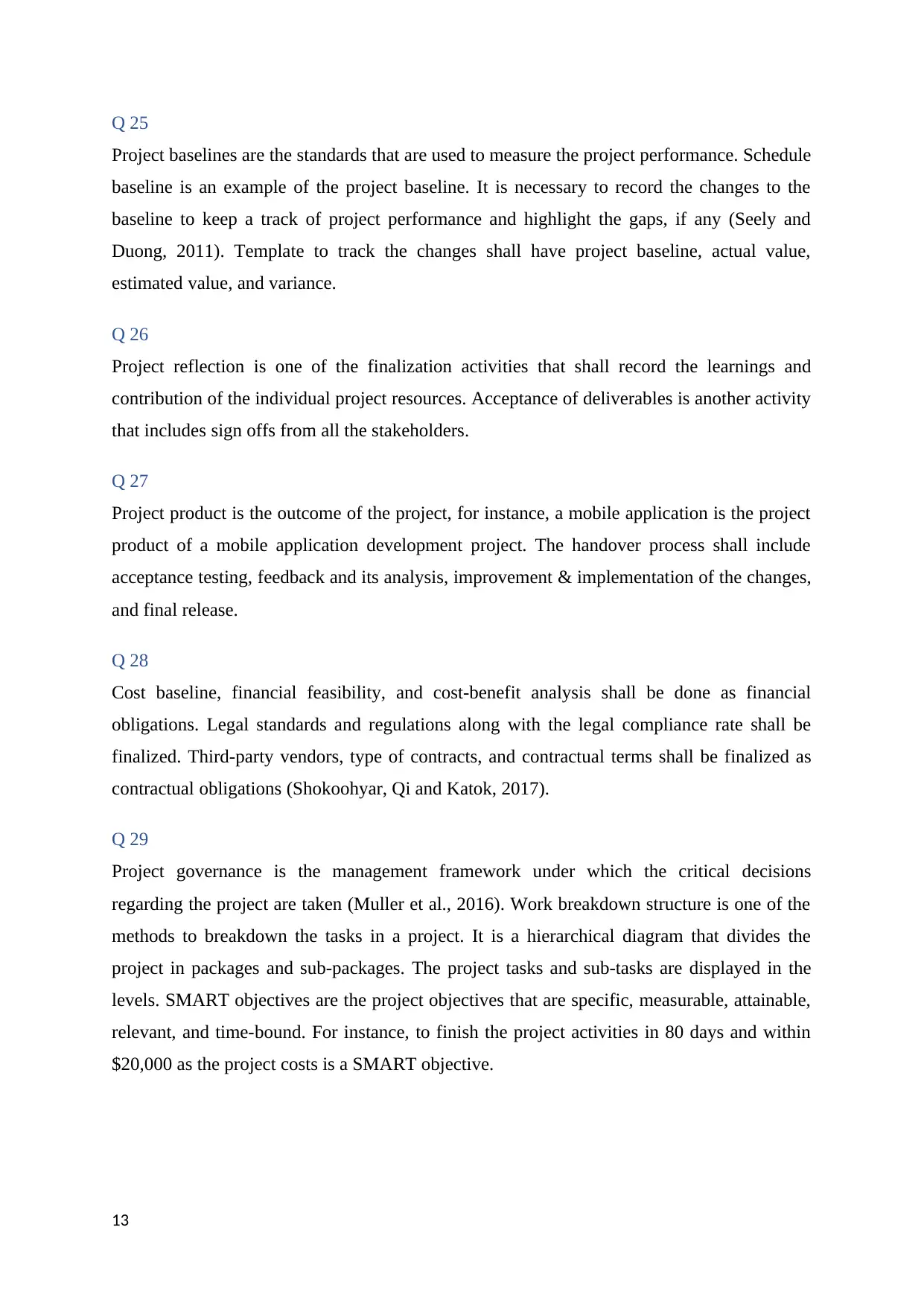
Q 25
Project baselines are the standards that are used to measure the project performance. Schedule
baseline is an example of the project baseline. It is necessary to record the changes to the
baseline to keep a track of project performance and highlight the gaps, if any (Seely and
Duong, 2011). Template to track the changes shall have project baseline, actual value,
estimated value, and variance.
Q 26
Project reflection is one of the finalization activities that shall record the learnings and
contribution of the individual project resources. Acceptance of deliverables is another activity
that includes sign offs from all the stakeholders.
Q 27
Project product is the outcome of the project, for instance, a mobile application is the project
product of a mobile application development project. The handover process shall include
acceptance testing, feedback and its analysis, improvement & implementation of the changes,
and final release.
Q 28
Cost baseline, financial feasibility, and cost-benefit analysis shall be done as financial
obligations. Legal standards and regulations along with the legal compliance rate shall be
finalized. Third-party vendors, type of contracts, and contractual terms shall be finalized as
contractual obligations (Shokoohyar, Qi and Katok, 2017).
Q 29
Project governance is the management framework under which the critical decisions
regarding the project are taken (Muller et al., 2016). Work breakdown structure is one of the
methods to breakdown the tasks in a project. It is a hierarchical diagram that divides the
project in packages and sub-packages. The project tasks and sub-tasks are displayed in the
levels. SMART objectives are the project objectives that are specific, measurable, attainable,
relevant, and time-bound. For instance, to finish the project activities in 80 days and within
$20,000 as the project costs is a SMART objective.
13
Project baselines are the standards that are used to measure the project performance. Schedule
baseline is an example of the project baseline. It is necessary to record the changes to the
baseline to keep a track of project performance and highlight the gaps, if any (Seely and
Duong, 2011). Template to track the changes shall have project baseline, actual value,
estimated value, and variance.
Q 26
Project reflection is one of the finalization activities that shall record the learnings and
contribution of the individual project resources. Acceptance of deliverables is another activity
that includes sign offs from all the stakeholders.
Q 27
Project product is the outcome of the project, for instance, a mobile application is the project
product of a mobile application development project. The handover process shall include
acceptance testing, feedback and its analysis, improvement & implementation of the changes,
and final release.
Q 28
Cost baseline, financial feasibility, and cost-benefit analysis shall be done as financial
obligations. Legal standards and regulations along with the legal compliance rate shall be
finalized. Third-party vendors, type of contracts, and contractual terms shall be finalized as
contractual obligations (Shokoohyar, Qi and Katok, 2017).
Q 29
Project governance is the management framework under which the critical decisions
regarding the project are taken (Muller et al., 2016). Work breakdown structure is one of the
methods to breakdown the tasks in a project. It is a hierarchical diagram that divides the
project in packages and sub-packages. The project tasks and sub-tasks are displayed in the
levels. SMART objectives are the project objectives that are specific, measurable, attainable,
relevant, and time-bound. For instance, to finish the project activities in 80 days and within
$20,000 as the project costs is a SMART objective.
13
Paraphrase This Document
Need a fresh take? Get an instant paraphrase of this document with our AI Paraphraser
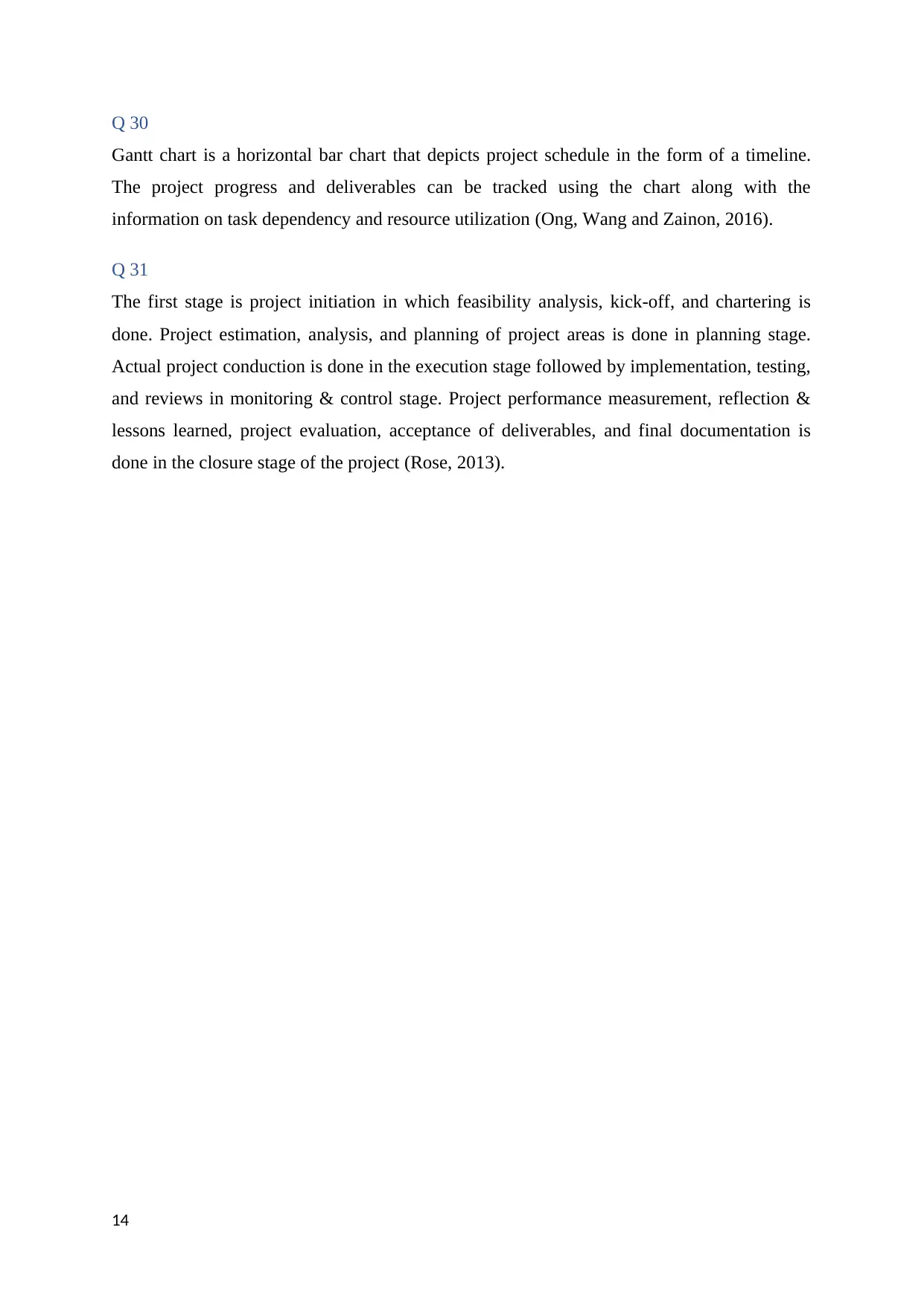
Q 30
Gantt chart is a horizontal bar chart that depicts project schedule in the form of a timeline.
The project progress and deliverables can be tracked using the chart along with the
information on task dependency and resource utilization (Ong, Wang and Zainon, 2016).
Q 31
The first stage is project initiation in which feasibility analysis, kick-off, and chartering is
done. Project estimation, analysis, and planning of project areas is done in planning stage.
Actual project conduction is done in the execution stage followed by implementation, testing,
and reviews in monitoring & control stage. Project performance measurement, reflection &
lessons learned, project evaluation, acceptance of deliverables, and final documentation is
done in the closure stage of the project (Rose, 2013).
14
Gantt chart is a horizontal bar chart that depicts project schedule in the form of a timeline.
The project progress and deliverables can be tracked using the chart along with the
information on task dependency and resource utilization (Ong, Wang and Zainon, 2016).
Q 31
The first stage is project initiation in which feasibility analysis, kick-off, and chartering is
done. Project estimation, analysis, and planning of project areas is done in planning stage.
Actual project conduction is done in the execution stage followed by implementation, testing,
and reviews in monitoring & control stage. Project performance measurement, reflection &
lessons learned, project evaluation, acceptance of deliverables, and final documentation is
done in the closure stage of the project (Rose, 2013).
14
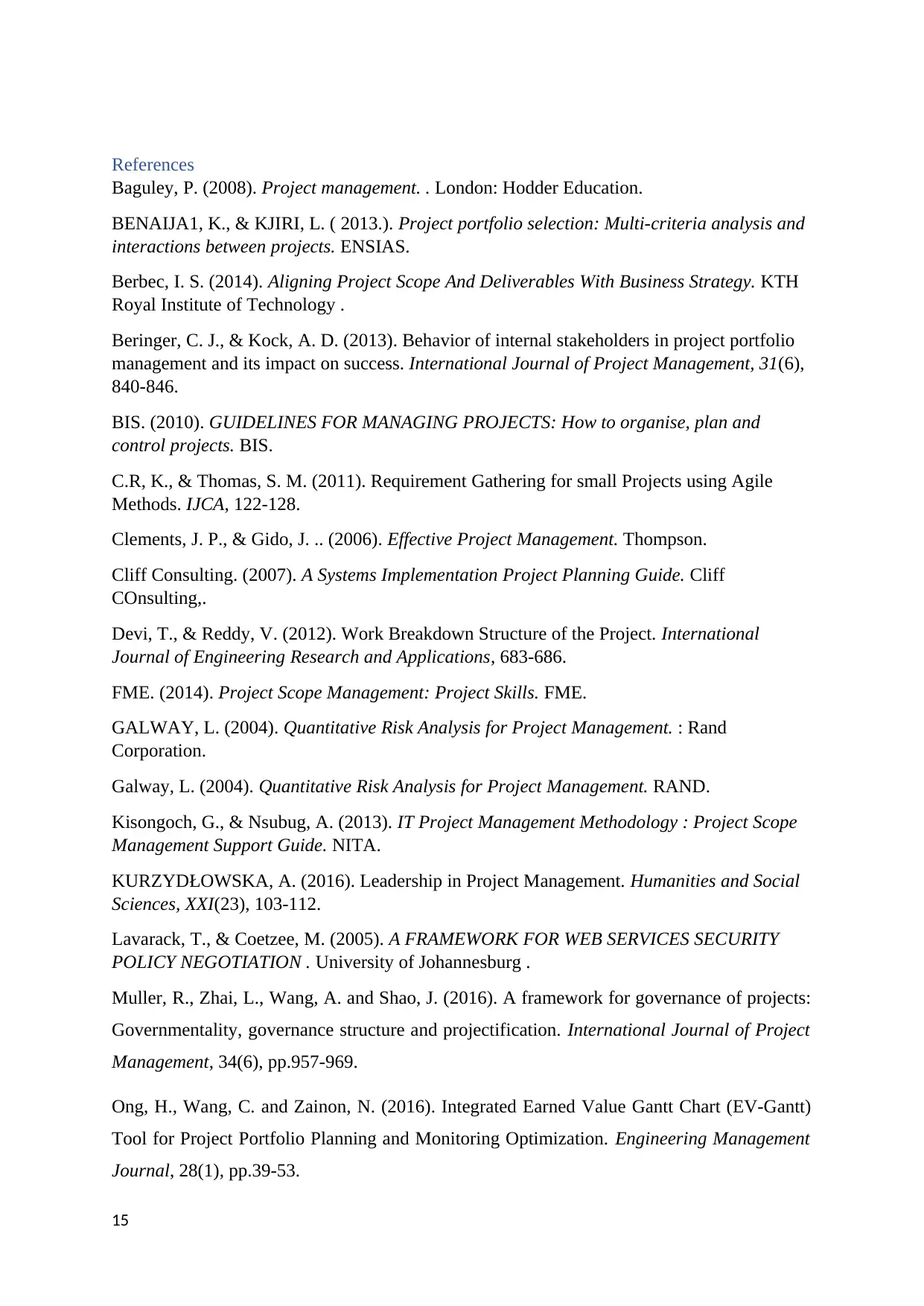
References
Baguley, P. (2008). Project management. . London: Hodder Education.
BENAIJA1, K., & KJIRI, L. ( 2013.). Project portfolio selection: Multi-criteria analysis and
interactions between projects. ENSIAS.
Berbec, I. S. (2014). Aligning Project Scope And Deliverables With Business Strategy. KTH
Royal Institute of Technology .
Beringer, C. J., & Kock, A. D. (2013). Behavior of internal stakeholders in project portfolio
management and its impact on success. International Journal of Project Management, 31(6),
840-846.
BIS. (2010). GUIDELINES FOR MANAGING PROJECTS: How to organise, plan and
control projects. BIS.
C.R, K., & Thomas, S. M. (2011). Requirement Gathering for small Projects using Agile
Methods. IJCA, 122-128.
Clements, J. P., & Gido, J. .. (2006). Effective Project Management. Thompson.
Cliff Consulting. (2007). A Systems Implementation Project Planning Guide. Cliff
COnsulting,.
Devi, T., & Reddy, V. (2012). Work Breakdown Structure of the Project. International
Journal of Engineering Research and Applications, 683-686.
FME. (2014). Project Scope Management: Project Skills. FME.
GALWAY, L. (2004). Quantitative Risk Analysis for Project Management. : Rand
Corporation.
Galway, L. (2004). Quantitative Risk Analysis for Project Management. RAND.
Kisongoch, G., & Nsubug, A. (2013). IT Project Management Methodology : Project Scope
Management Support Guide. NITA.
KURZYDŁOWSKA, A. (2016). Leadership in Project Management. Humanities and Social
Sciences, XXI(23), 103-112.
Lavarack, T., & Coetzee, M. (2005). A FRAMEWORK FOR WEB SERVICES SECURITY
POLICY NEGOTIATION . University of Johannesburg .
Muller, R., Zhai, L., Wang, A. and Shao, J. (2016). A framework for governance of projects:
Governmentality, governance structure and projectification. International Journal of Project
Management, 34(6), pp.957-969.
Ong, H., Wang, C. and Zainon, N. (2016). Integrated Earned Value Gantt Chart (EV-Gantt)
Tool for Project Portfolio Planning and Monitoring Optimization. Engineering Management
Journal, 28(1), pp.39-53.
15
Baguley, P. (2008). Project management. . London: Hodder Education.
BENAIJA1, K., & KJIRI, L. ( 2013.). Project portfolio selection: Multi-criteria analysis and
interactions between projects. ENSIAS.
Berbec, I. S. (2014). Aligning Project Scope And Deliverables With Business Strategy. KTH
Royal Institute of Technology .
Beringer, C. J., & Kock, A. D. (2013). Behavior of internal stakeholders in project portfolio
management and its impact on success. International Journal of Project Management, 31(6),
840-846.
BIS. (2010). GUIDELINES FOR MANAGING PROJECTS: How to organise, plan and
control projects. BIS.
C.R, K., & Thomas, S. M. (2011). Requirement Gathering for small Projects using Agile
Methods. IJCA, 122-128.
Clements, J. P., & Gido, J. .. (2006). Effective Project Management. Thompson.
Cliff Consulting. (2007). A Systems Implementation Project Planning Guide. Cliff
COnsulting,.
Devi, T., & Reddy, V. (2012). Work Breakdown Structure of the Project. International
Journal of Engineering Research and Applications, 683-686.
FME. (2014). Project Scope Management: Project Skills. FME.
GALWAY, L. (2004). Quantitative Risk Analysis for Project Management. : Rand
Corporation.
Galway, L. (2004). Quantitative Risk Analysis for Project Management. RAND.
Kisongoch, G., & Nsubug, A. (2013). IT Project Management Methodology : Project Scope
Management Support Guide. NITA.
KURZYDŁOWSKA, A. (2016). Leadership in Project Management. Humanities and Social
Sciences, XXI(23), 103-112.
Lavarack, T., & Coetzee, M. (2005). A FRAMEWORK FOR WEB SERVICES SECURITY
POLICY NEGOTIATION . University of Johannesburg .
Muller, R., Zhai, L., Wang, A. and Shao, J. (2016). A framework for governance of projects:
Governmentality, governance structure and projectification. International Journal of Project
Management, 34(6), pp.957-969.
Ong, H., Wang, C. and Zainon, N. (2016). Integrated Earned Value Gantt Chart (EV-Gantt)
Tool for Project Portfolio Planning and Monitoring Optimization. Engineering Management
Journal, 28(1), pp.39-53.
15

PM4DEV. (2016). Project Scope Management for Developing Organizations. PM4DEV.
PMI. (2013). A Guide to Project Management Body of Knowledge. PMI.
PMI. (2013). A guide to the project management body of knowledge. Newton Square:
Pennsylvania.: PMI.
Raz, T. M. (2001). Use and benefits of tools for project risk management. International
Journal of Project Management, 19, 9-17.
Rose, K. (2013). A Guide to the Project Management Body of Knowledge (PMBOK®
Guide)-Fifth Edition. Project Management Journal, 44(3), pp.e1-e1.
Sabyasachi. (2018). The Importance of Having Clearly Defined Acceptance Criteria in Your
Projects. Simplilearn.
SAEO. (2015). Cost Estimating Manual for Projects . SAEO.
SAEO. (2015). Cost Estimating Manual for Projects . SAEO.
Sanderson, J. (2012). Risk, uncertainty and governance in mega projects - A critical
discussion of alternative explanations. International Journal of Project Management, 30,
432-443.
Schuyler, J. (2001). Risk and Decision Analysis in Projects. Newton Square, PA: Project
Management Institute.
Seely, M. and Duong, Q. (2011). The Dynamic Baseline Model for Project Management.
Project Management Journal, 32(2), pp.25-36.
Shokoohyar, S., Qi, A. and Katok, E. (2017). Project Management under Risk-Sharing
Contracts. SSRN Electronic Journal.
Treasury Board of Canada . (2010). A Guide to Project Gating for IT-Enabled Projects .
Treasury Board of Canada.
Virine, L. (2013). Integrated Qualitative and Quantitative Risk Analysis of Project
Portfolios. Casualty Actuarial Society.
WIllis, S. (2018). Project Governance Framework. University of Otago.
16
PMI. (2013). A Guide to Project Management Body of Knowledge. PMI.
PMI. (2013). A guide to the project management body of knowledge. Newton Square:
Pennsylvania.: PMI.
Raz, T. M. (2001). Use and benefits of tools for project risk management. International
Journal of Project Management, 19, 9-17.
Rose, K. (2013). A Guide to the Project Management Body of Knowledge (PMBOK®
Guide)-Fifth Edition. Project Management Journal, 44(3), pp.e1-e1.
Sabyasachi. (2018). The Importance of Having Clearly Defined Acceptance Criteria in Your
Projects. Simplilearn.
SAEO. (2015). Cost Estimating Manual for Projects . SAEO.
SAEO. (2015). Cost Estimating Manual for Projects . SAEO.
Sanderson, J. (2012). Risk, uncertainty and governance in mega projects - A critical
discussion of alternative explanations. International Journal of Project Management, 30,
432-443.
Schuyler, J. (2001). Risk and Decision Analysis in Projects. Newton Square, PA: Project
Management Institute.
Seely, M. and Duong, Q. (2011). The Dynamic Baseline Model for Project Management.
Project Management Journal, 32(2), pp.25-36.
Shokoohyar, S., Qi, A. and Katok, E. (2017). Project Management under Risk-Sharing
Contracts. SSRN Electronic Journal.
Treasury Board of Canada . (2010). A Guide to Project Gating for IT-Enabled Projects .
Treasury Board of Canada.
Virine, L. (2013). Integrated Qualitative and Quantitative Risk Analysis of Project
Portfolios. Casualty Actuarial Society.
WIllis, S. (2018). Project Governance Framework. University of Otago.
16
1 out of 16
Related Documents
Your All-in-One AI-Powered Toolkit for Academic Success.
+13062052269
info@desklib.com
Available 24*7 on WhatsApp / Email
![[object Object]](/_next/static/media/star-bottom.7253800d.svg)
Unlock your academic potential
© 2024 | Zucol Services PVT LTD | All rights reserved.





